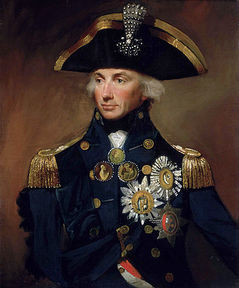210-Year-Old Lesson
In October of 1805, British Admiral Horatio Nelson faced a daunting threat in an effort to defend the British Isles from a Franco-German armada focused on defeating his lesser force and opening the way for an invasion of Britain. Nelson had 19 ships against the enemy’s 33. The Battle of Trafalgar loomed…
The classic method for fighting warships in those days was to align them across from one another and fire cannon across the void until one of the forces surrenders, or sinks. This parallel alignment also enabled the admiral to direct actions of his ships via flag signals down the line. It was a brutal approach, pitting force against force with a central command to direct the action. The thing is, that’s a tough way to manage things when the opposing force doesn’t behave as you expect. That’s especially true when disruption and chaos ensue.
Nelson, outnumbered and outmanned, decided to change the rules of engagement. He gathered the captains of his ships and shared with them an entirely different approach; they would divide their ships into two lines, sailing perpendicular to the Franco-German ships, and go right at them with the intent of dividing the enemy ships into three sections, disrupting signals and creating chaos as they fired directly into the ships as they crossed the line.
Wind direction favored Nelson as he sailed his 227 foot wooden warship ‘Victory’ and the rest of his fleet across the void and directly into the enemy line. This move confused and then decimated the Franco-German force. Nelson knew this would create chaos and in his direction to his other captains said that no man could go too wrong if he were to “place his ship alongside that of the enemy.” They did and, as the smoke cleared that day, no British ships were lost; 19 of the 33 enemy vessels were captured, however. The British Navy decisively won the Battle of Trafalgar, by employing an unorthodox but highly informed and shared approach.
This novel battle plan depended upon Nelson’s captains and crews fully understanding the overall battle plan and objectives. The “entrepreneurial” approach he planned was dependent upon shared purpose and clarity of focus. The Franco-German ships didn’t have that; in fact, Napoleon had made it quite clear to Vice Admiral Pierre-Charles Villeneuve that he absolutely could not share with other officers what the plan for defeating England might be. The 33 Franco-German ships were suddenly in the fog of battle without a signal flag to read. And there was none….
Cool history lesson? I hope so. When I read about this old sea battle recently in a current book on leadership, I was captivated by the idea of how such an informational and structural change could create such an unexpected outcome. Those lessons are surprisingly relevant to business in our day and time. A generation or so ago, people in business were waiting for signals from the leaders regarding what to do, when, and how. But then the world changed and the Information Age dawned. Old rules out; new rules in. The fascinating thing is that the “new” rules mirror those adopted by Admiral Nelson 210 years ago. Know “Why”, “How” and finally “What” needs to happen and fully share that with your team; then go accomplish it.
If you’re equipped with that knowledge, you can win a battle equally important to the Battle of Trafalgar for the British in 1805. You’re equipped to win the Business Battle of the 21st Century!
The classic method for fighting warships in those days was to align them across from one another and fire cannon across the void until one of the forces surrenders, or sinks. This parallel alignment also enabled the admiral to direct actions of his ships via flag signals down the line. It was a brutal approach, pitting force against force with a central command to direct the action. The thing is, that’s a tough way to manage things when the opposing force doesn’t behave as you expect. That’s especially true when disruption and chaos ensue.
Nelson, outnumbered and outmanned, decided to change the rules of engagement. He gathered the captains of his ships and shared with them an entirely different approach; they would divide their ships into two lines, sailing perpendicular to the Franco-German ships, and go right at them with the intent of dividing the enemy ships into three sections, disrupting signals and creating chaos as they fired directly into the ships as they crossed the line.
Wind direction favored Nelson as he sailed his 227 foot wooden warship ‘Victory’ and the rest of his fleet across the void and directly into the enemy line. This move confused and then decimated the Franco-German force. Nelson knew this would create chaos and in his direction to his other captains said that no man could go too wrong if he were to “place his ship alongside that of the enemy.” They did and, as the smoke cleared that day, no British ships were lost; 19 of the 33 enemy vessels were captured, however. The British Navy decisively won the Battle of Trafalgar, by employing an unorthodox but highly informed and shared approach.
This novel battle plan depended upon Nelson’s captains and crews fully understanding the overall battle plan and objectives. The “entrepreneurial” approach he planned was dependent upon shared purpose and clarity of focus. The Franco-German ships didn’t have that; in fact, Napoleon had made it quite clear to Vice Admiral Pierre-Charles Villeneuve that he absolutely could not share with other officers what the plan for defeating England might be. The 33 Franco-German ships were suddenly in the fog of battle without a signal flag to read. And there was none….
Cool history lesson? I hope so. When I read about this old sea battle recently in a current book on leadership, I was captivated by the idea of how such an informational and structural change could create such an unexpected outcome. Those lessons are surprisingly relevant to business in our day and time. A generation or so ago, people in business were waiting for signals from the leaders regarding what to do, when, and how. But then the world changed and the Information Age dawned. Old rules out; new rules in. The fascinating thing is that the “new” rules mirror those adopted by Admiral Nelson 210 years ago. Know “Why”, “How” and finally “What” needs to happen and fully share that with your team; then go accomplish it.
If you’re equipped with that knowledge, you can win a battle equally important to the Battle of Trafalgar for the British in 1805. You’re equipped to win the Business Battle of the 21st Century!








2 Comments
Leave a Reply
Lisa Hall
10 years agoCool story Bill! Very relative to business success and our approach to the challenging situations we face daily. Thinking outside the box leads to fresh ideas and successful outcomes.
Michael Paradise
10 years agoI am still Processing what you said but never the less. You are the man Bill.